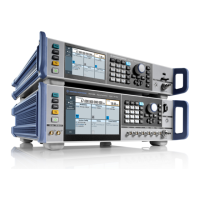Preparing for Use
R&S
®
SMA100B
22Getting Started 1419.8620.02 ─ 08
To prepare for connecting to "RF"
1. NOTICE! Damaged or not clean connections can lead to RF insertion loss
and mismatch, and even premature wear of the connectors.
Before connecting to the port, inspect the RF connector visually to check that
it is clean, undamaged and mechanically compatible.
See the application note 1MA99 for information on how to handle and main-
tain the RF port, to minimize measurement deviations and ensure its longevity.
2. NOTICE! Risk of instrument damage. Excessive reverse power or DC voltage
at the RF connector can damage the instrument.
Make sure that the values do not exceed the reverse power and DC limits as
given in the data sheet.
3. If the R&S SMA100B is switched on, deactivate the RF output, before con-
necting an RF cable to the RF connector.
In the home screen, select the block "Level" > "RF ON > Off".
4. Use a high-quality RF cable that matches the RF connector type.
See "Cable selection and electromagnetic interference (EMI)" on page 18.
To connect to screwable connectors
1. Use a high-quality cable that matches the connector type.
See "Cable selection and electromagnetic interference (EMI)" on page 18.
2. NOTICE! Risk of instrument damage and connector damage. Excessive tight-
ening can damage the cables and the connectors. However, if you do not
tighten the connectors enough, the measurement results can be inaccurate.
To connect the cable with the connector, proceed as follows:
a) Carefully align the connector of the cable and the connector along a com-
mon axis.
b) Mate the connectors along the common axis until the male pin of the inner
connector engages with the female socket of the outer connector.
c) Turn the nut of the outer connector until the connectors are firmly coupled.
d) Torque the nut to the specified limit using a calibrated torque wrench. Hold
the opposite connector part stationary with a spanner.
For torque limits of the most relevant connector types, see Table 4-1.
3. Torque the nut to the specified limit using a calibrated torque wrench. Hold the
opposite connector part stationary with a spanner.
For more information, see chapter "Handling" of the application note 1MA99.
Connecting to RF

